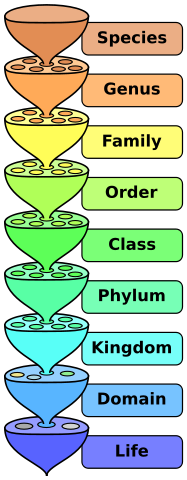How Does the Hot Pepper Fit Into the World?
The hot pepper is well known for the spice it produces. This spice is called capsaicin and is special to the genus Capsicum. On this page you will find the classification of hot peppers broken down into Domain, Kingdom, Phylum, Class, Order, Family, Genus, and finally Species. There is much debate as to which species is the main hot pepper species, but the three most talked about species are listed under the species area. You will also find two phylogenetic trees to help you understand how hot peppers fit in.
Domain- Eukaryota- The Hot pepper cell has a nucleus and
other complex structures within membranes in the cell.
Kingdom- Plantae- The Hot Pepper plant is photosynthetic.
Phylum- Anthophyta (Angiosperms): The Hot Pepper is a flowering plant. The seeds develop within the flowers ovary, and then the ovary develops into the fruit (the pepper itself).

Class- Eudicotyledones: The two biggest things you look for in eudicotyledones are veins that are netlike and flowers that are in multiples of two, four or five. The Hot Pepper plant has both of these. To see an example of another eudicotyledone click here! To see an example of a monocotyledone click here! (the opposite of a eudicotyledone)
Order- Solanales- The stems have branched hairs.
Family- Solanaceae- The ovary is inside the flower, and the fruit is a capsule, containing many light brown disc-shaped seeds. Tomatoes, potatoes, and eggplants are also in this family.

Genus- Capsicum- The Hot pepper produces capsaicin which is the hot spice that you taste. The only capsicum without any capsaicin, and therefore no heat, is the bell pepper.
Species- Capsicum
frutescens
Capsicum annuum
Capsicum chinense
Here are two phylogenetic trees to further help you understand where the hot pepper fits in. A phylogenetic tree is a diagram showing evolutionary lineages of organisms.
This first phylogenetic tree shows how the hot pepper relates to other organisms. The first branch point at the top separates the hot peppers from the tomato, potato and cowpea. This means that the tomato, potato and cowpea are more closely related to each other than they are to the hot peppers. The second branch point on the right of the image separates the cowpea from the potato and tomato. Again, this means that the tomato and potato are more closely related to each other than they are the cowpea. And finally the last branch point separates the potato from the tomato.
The phylogenetic tree below shows different kinds of hot peppers and how they relate to each other. The first branch point separates the Tabasco pepper from the Yolo Wonder and Perennial peppers. This means that the Yolo Wonder and the Perennial peppers are more closely related to each other than they are to the Tabasco. The second branch point on the left side of the image separates the Yolo Wonder from the Perennial peppers.
Now that you know a little about how the hot pepper fits into the world, lets look at where the hot pepper is found in the world. Click here to go to the hot peppers Habitat.










